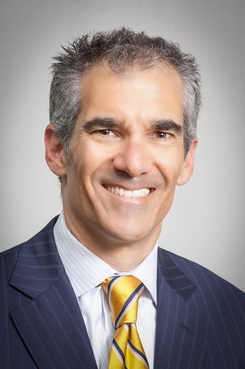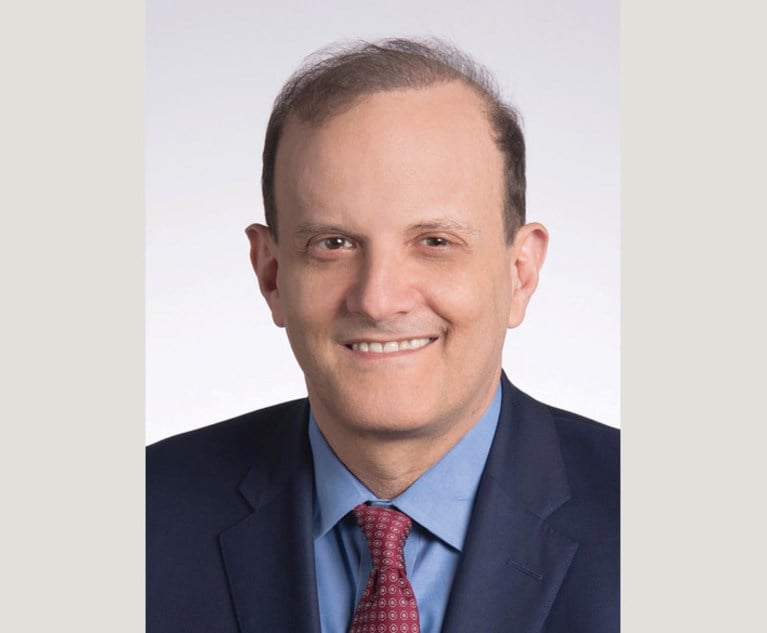Hospital Successfully Defends Termination After Nurse Returns From Opioid Abuse Treatment
While current drug use is not protected under the Americans with Disabilities Act, drug addiction is. Employers often struggle with the legal obligations associated with drug use and distinguishing between current use and past addiction.
December 11, 2018 at 01:27 PM
7 minute read
 Sid Steinberg of Post & Schell
Sid Steinberg of Post & Schell
While current drug use is not protected under the Americans with Disabilities Act, drug addiction is. Employers often struggle with the legal obligations associated with drug use and distinguishing between current use and past addiction. The recent decision in Suarez v. Pennsylvania Hospital of the University of Pennsylvania Health System, No. 18-1596, 2018 U.S. Dist. LEXIS 202098 (E.D. Pa. Nov. 29, 2018), addresses many of these issues in a particularly timely way, as the employee struggled with opioid addiction—which of course is much in the news.
Nursing License Limitations
Melissa Suarez was hired by Pennsylvania Hospital to work as a nurse in the emergency department in 2013. Suarez had a history of opioid addiction and at the time she was hired, her license to practice was subject to monitoring by the Pennsylvania Board of Nursing. The hospital was aware of Suarez's probationary status and understood that the board's monitoring did not prevent her from performing the responsibilities of a clinical nurse II in the emergency department. Suarez performed well and was even promoted to the position of clinical nurse III in 2015.
In July 2016, Suarez took 12 weeks of FMLA leave for the birth of her son. In October, Suarez was prescribed Oxycodone for back pain. A few weeks later, she reported for work and was observed to be lethargic and “not acting appropriately” by her peers. Although her drug test tested positive for opioids, Suarez was nevertheless permitted to return to work when she provided prescriptions for the drugs.
Depression Diagnosis
Shortly after the drug test, Suarez spoke to a manager and the Human Resources Manager Len Umile during which she said that she had been taking anti-depressants. The hospital asked “what they could do to help her,” to which Suarez responded that she needed time off and “a lot of help.” In response, the hospital advised that she could work part-time or per diem but that she could not take time off “because she had exhausted all of her time.” Suarez responded that she could not afford to work part-time or per diem.
In December 2016, Suarez requested intermittent FMLA to care for her son, who had been recently diagnosed with asthma. This request was denied because, again, she had exhausted her FMLA leave after giving birth. Suarez again sought FMLA leave in February when she checked into a drug rehabilitation facility but, again, such leave was denied as having been exhausted. However, Suarez successfully applied for leave as accommodation under the Americans with Disabilities Act citing her addiction as a disability—as she was checking in to a drug rehabilitation facility. This request was approved.
Additional License Limitations
When the hospital was advised that Suarez was ready to return, it advised her that she should report her drug usage to the Board of Nursing and that she should disclose it on her nursing license renewal form. In doing so, Suarez “entered into a contract with the board which restricted her from practicing nursing 'in any capacity that involves the administration of controlled substances for a period of at least six months following her return to work as a nurse.'” This restriction prohibited Suarez from working as an emergency department nurse.
Shortly thereafter, the hospital sent Suarez notice that it was posting her position “but would keep Suarez listed as an active employee until she could return” to her employment. Umile advised Suarez that she should review open and available positions on the hospital's website to “see what looks like what may be a good fit” and that she should tell him when she applied for positions within her limitations. It was anticipated that Suarez could work in “a nonbedside” nursing position. Suarez interviewed for one case management position but was unable to “commit” to the job because it would have required her to work five days per week, which presented difficulties due to her child care schedule. On Oct. 1, 2017, after approximately 90 days of her unsuccessful intra-hospital job search, Suarez was terminated from her employment. She subsequently brought suit under the ADA claiming, principally, that the hospital failed to reinstate her to a nonbedside nursing position and ultimately fired her because of her depression and her status as a recovering drug addict.
Drug Addiction Is a Covered Disability
The court initially addressed the distinction between “current” drug use, which is not protected under the ADA, and being a recovering drug addict, which is. The court noted that the EEOC's technical assistance manual provides that “an employee's drug use is current if it occurred recently enough to justify the employer's reasonable belief that the employee's involvement with drugs is an ongoing problem.” An employee is a recovering addict if she is “addicted to drugs but no longer 'currently engaging' in illegal use.” Because this is a case-by-case analysis, the court found that Suarez had created a genuine issue of fact on this particular issue.
Suarez was also able to establish that she was “qualified” for nonbedside positions, but her prima facie case failed, as there was no evidence that either of her disabilities (drug addiction and depression) were a “determinative factor” in the hospital's decision. Specifically, the hospital learned that Suarez had been diagnosed with depression during the course of her treatment at the rehabilitation facility, from which she was released in March 2017. As such, there was no temporal proximity with her termination on Oct. 1. This was particularly the case inasmuch as “the hospital permitted her to continue applying for new positions for more than six months after her diagnosis.”
The court found that even if Suarez has successfully presented a prima facie case (and she had not), there was no evidence of pretext based upon Suarez's restrictions and the hospital's efforts to place her in a nonbedside position. As such, summary judgment was granted to the hospital.
Optimal ADA Compliance
The lesson for employers is the clear efforts of the hospital to work with Suarez to preserve her employment in the face of her limitations and her various attempts to remain employed. This began with the hospital's conversation with Suarez in November 2016 in which the HR manager inquired as to “what they could do to help her.” By opening the door to any suggestion from Suarez, the hospital demonstrated that it valued her employment and asked for a suggested accommodation rather than imposing one upon her—or even worse, simply limiting her employment at that point.
Further, it is evident that the hospital sought to assist her nonbedside job search and only took action when such a search was unsuccessful. This is the optimal way for the ADA to work—attempting to preserve employment and, if that fails, putting the employer in the strongest defense position possible.
Sid Steinberg is a principal and chair of Post & Schell's employment and employee relations and labor practice groups. Steinberg's practice involves virtually all aspects of employee relations, including litigation experience defending employers against employment discrimination in federal and state courts. He also represents employers before federal, state and local administrative agencies, and regularly advises employers in matters including employee discipline, labor relations, and the creation or revision of employee handbooks. He can be reached at [email protected].
This content has been archived. It is available through our partners, LexisNexis® and Bloomberg Law.
To view this content, please continue to their sites.
Not a Lexis Subscriber?
Subscribe Now
Not a Bloomberg Law Subscriber?
Subscribe Now
NOT FOR REPRINT
© 2025 ALM Global, LLC, All Rights Reserved. Request academic re-use from www.copyright.com. All other uses, submit a request to [email protected]. For more information visit Asset & Logo Licensing.
You Might Like
View All

Essential Labor Shifts: Navigating Noncompetes, Workplace Politics and the AI Revolution


Employment Law Developments to Expect From the Second Trump Administration
8 minute readTrending Stories
- 1'It's Not Going to Be Pretty': PayPal, Capital One Face Novel Class Actions Over 'Poaching' Commissions Owed Influencers
- 211th Circuit Rejects Trump's Emergency Request as DOJ Prepares to Release Special Counsel's Final Report
- 3Supreme Court Takes Up Challenge to ACA Task Force
- 4'Tragedy of Unspeakable Proportions:' Could Edison, DWP, Face Lawsuits Over LA Wildfires?
- 5Meta Pulls Plug on DEI Programs
Who Got The Work
Michael G. Bongiorno, Andrew Scott Dulberg and Elizabeth E. Driscoll from Wilmer Cutler Pickering Hale and Dorr have stepped in to represent Symbotic Inc., an A.I.-enabled technology platform that focuses on increasing supply chain efficiency, and other defendants in a pending shareholder derivative lawsuit. The case, filed Oct. 2 in Massachusetts District Court by the Brown Law Firm on behalf of Stephen Austen, accuses certain officers and directors of misleading investors in regard to Symbotic's potential for margin growth by failing to disclose that the company was not equipped to timely deploy its systems or manage expenses through project delays. The case, assigned to U.S. District Judge Nathaniel M. Gorton, is 1:24-cv-12522, Austen v. Cohen et al.
Who Got The Work
Edmund Polubinski and Marie Killmond of Davis Polk & Wardwell have entered appearances for data platform software development company MongoDB and other defendants in a pending shareholder derivative lawsuit. The action, filed Oct. 7 in New York Southern District Court by the Brown Law Firm, accuses the company's directors and/or officers of falsely expressing confidence in the company’s restructuring of its sales incentive plan and downplaying the severity of decreases in its upfront commitments. The case is 1:24-cv-07594, Roy v. Ittycheria et al.
Who Got The Work
Amy O. Bruchs and Kurt F. Ellison of Michael Best & Friedrich have entered appearances for Epic Systems Corp. in a pending employment discrimination lawsuit. The suit was filed Sept. 7 in Wisconsin Western District Court by Levine Eisberner LLC and Siri & Glimstad on behalf of a project manager who claims that he was wrongfully terminated after applying for a religious exemption to the defendant's COVID-19 vaccine mandate. The case, assigned to U.S. Magistrate Judge Anita Marie Boor, is 3:24-cv-00630, Secker, Nathan v. Epic Systems Corporation.
Who Got The Work
David X. Sullivan, Thomas J. Finn and Gregory A. Hall from McCarter & English have entered appearances for Sunrun Installation Services in a pending civil rights lawsuit. The complaint was filed Sept. 4 in Connecticut District Court by attorney Robert M. Berke on behalf of former employee George Edward Steins, who was arrested and charged with employing an unregistered home improvement salesperson. The complaint alleges that had Sunrun informed the Connecticut Department of Consumer Protection that the plaintiff's employment had ended in 2017 and that he no longer held Sunrun's home improvement contractor license, he would not have been hit with charges, which were dismissed in May 2024. The case, assigned to U.S. District Judge Jeffrey A. Meyer, is 3:24-cv-01423, Steins v. Sunrun, Inc. et al.
Who Got The Work
Greenberg Traurig shareholder Joshua L. Raskin has entered an appearance for boohoo.com UK Ltd. in a pending patent infringement lawsuit. The suit, filed Sept. 3 in Texas Eastern District Court by Rozier Hardt McDonough on behalf of Alto Dynamics, asserts five patents related to an online shopping platform. The case, assigned to U.S. District Judge Rodney Gilstrap, is 2:24-cv-00719, Alto Dynamics, LLC v. boohoo.com UK Limited.
Featured Firms
Law Offices of Gary Martin Hays & Associates, P.C.
(470) 294-1674
Law Offices of Mark E. Salomone
(857) 444-6468
Smith & Hassler
(713) 739-1250





